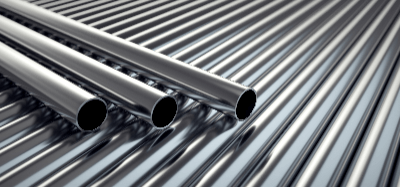What Is a Stainless Steel Pipe?

Stainless steel pipes are piping made of stainless steel.
Among stainless steels, austenitic stainless steels such as SUS304 do not rust because the surface is protected by a non-conductive film due to the chromium contained. For this reason, it is used for piping where rust is a problem. Another feature of stainless steel pipe is its resistance to high and low temperatures.
Pipes with bright annealed (non-oxidation annealed) or electropolished inner surfaces can also be used in semiconductor and food factories, where high-purity products are required.
Uses of Stainless Steel Pipes
Stainless steel tubing is widely used in factories and plants. Specific applications are as follows:
- Chemical plants with high temperature reactions
- Industrial gas plants that convey ultra-low-temperature liquids
- Food and pharmaceutical plants where the presence of foreign matter and bacteria is strictly prohibited
- Semiconductor plants where high-purity products are required
- Sulfuric acid plants and caustic soda plants
- Coal-fired power plants
- Liquid oxygen and liquid nitrogen transfer piping
Stainless steel pipes are widely used in piping where rust is a problem and are sometimes used for pure water and steam piping.
Principle of Stainless Steel Pipes
Among stainless steel pipes, those made of austenitic stainless steel do not rust due to the non-conductive coating of chromium. However, corrosion resistance may decrease due to a phenomenon called sensitization caused by heat during welding.
In particular, chromium becomes chromium carbide in the vicinity of the welding area, and there may not be enough chromium to form a non-conductive film. To avoid this phenomenon, heat control during welding is necessary.
In addition, stainless steel pipes that are bright annealed (non-oxidation annealed) or electropolished on the inside have a clean appearance and are free of residual areas that can cause contamination. For this reason, stainless steel pipes are widely used in the food industry and semiconductor plants. If stainless steel pipes are welded incorrectly, liquid accumulation and unevenness in the welding area can occur. Therefore, accurate installation is necessary to fully demonstrate the capabilities of stainless steel pipe.
Other Information on Stainless Steel Pipes
1. Difference Between Stainless Steel Pipe for Piping and Stainless Steel Pipe for General Piping
Stainless steel pipes for piping are stainless steel pipes used for corrosion resistance and low temperature applications. Outer diameters often range from 10.5 mm to 660.4 mm.
On the other hand, stainless steel pipes for general piping are stainless steel pipes used for water supply and hot water supply. They are thinner-walled than conventional stainless steel pipes and are classified into four types: SUS304, SUS315J1, SUS315J2, and SUS316. Outer diameters range from 9.52 mm to 318.5 mm.
2. Water Supply and Stainless Steel Pipes
Similar to stainless steel pipe for general piping, stainless steel pipe for waterworks is a standard. Stainless steel pipes for water supply are used for water supplies with a maximum working pressure of 1.0 MPa or less.
The wall thickness is the same as that of stainless steel pipes for general piping and is characterized by the two types of SUS304 and SUS316 specified. Pipes with outside diameters ranging from 15.88 mm to 48.60 mm are available.
3. Stainless Steel Pipe Fittings
Stainless steel pipe fittings are parts used to connect stainless steel pipes. By using fittings, the direction of stainless steel pipes can be changed and the size of the outside diameter can be changed.
Typical types of fittings are as follows:
- Elbow – Change the direction of piping to 45°, 90°, or 180°.
- T-shaped – Merging and branching of pipes
- Reducers – Connect pipes with different outside diameters
- Bushing – Connects pipes of different diameters with external and internal threads.
- Nipple – Connects the inner threads of pipes.
- Socket – Socket Connects two external threads of piping.
- Flange – Connect piping to piping
There are two main types of connection methods: welding and screw-in. The welding type includes butt-welding pipe fittings and insert-welding pipe fittings, while the screwing type includes threaded pipe fittings. Threaded pipe fittings are also attractive because they are not fixed by welding and are easy to repair and maintain.